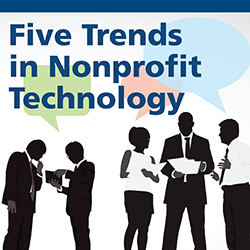Five Trends in Nonprofit Technology
Introduction
Traditionally, the funders who provide critical income streams to nonprofits – foundations, individual donors, and government entities – have only made this issue worse by encouraging nonprofits, at least implicitly, to devote as much money as possible to direct program services rather than “overhead” costs such as technology. However, that attitude is slowly changing. In recent years, there has been an increasing awareness that investments in technology can lower staff costs, increase the effectiveness of programs, and help nonprofits reach out to the right groups of people.
What does this mean in practice? We’ve identified five trends that, when viewed together, provide a good picture of the use of technology in the nonprofit world today.
CRM and the Integration of Everything
Nonprofits have heard the business world singing the praises of Customer Relationship Management (CRM), and in response, a number of organizations are looking to implement a similar system to provide staff members a full 360-degree view of each donor, volunteer, and client. This push toward CRM, known as Constituent Relationship Management in the nonprofit world, means different things to different nonprofits, but it’s leading to healthy reflection on what systems and processes make sense, as well as a move toward fewer systems and more integration. This is a great step forward in a world where data silos are still all too common.
While many organizations associate CRM with the desire to support all constituent data and processes in one single system, the reality is that for many nonprofits, this simply may not be practical.
Human services organizations, for instance, often have very detailed requirements and strict privacy regulations around their client case histories, but may also need advanced fundraising capabilities, integration between their donor records and website, and sophisticated social media capabilities. They’re unlikely to find any system to fill all of these needs at any price – let alone one they can afford.
For many organizations, CRM requires more of a strategy than a single system. Most in the sector aren’t yet at the point where they’re thinking about details cross-system integration. However, this is likely to be the next step for even midsized nonprofits over the next couple of years.
Metrics and Dashboards
Foundations and government funders have heard a clear call from the public to quantify and validate the impact of their support. In turn, they have substantially increased their interested in measuring the success of grantee programs, putting nonprofits under a great deal of pressure to track more data about their programs and constituents and translate it into meaningful metrics. This could include such detailed information as attendance and staff activities, comparison client data from before and after their involvement in a program, and bigger-picture questions contrasting the population served by programs with the greater population. Ideally, nonprofits would like to be able to robustly track all of these kinds of data alongside other constituent data and allow staff to report on it.
This growth of interest in metrics has led to an interest in dashboards to monitor them. While it’s often unclear to organizations exactly how they would pull all the needed data and display it in one place, they’d like to have easy-to-use and easy-to-access reports that senior staff – or all staff – could use to check on organizational and programmatic metrics.
Democratization of Data
Even just a few years ago, it wasn’t uncommon for all of a nonprofit’s data to live in the hands of a data manager, who would run all the reports, oversee data entry, and ensure the overall quality of the organization’s records. Today, there is a growing expectation that everyone in an organization will have the ability to access data. This expectation creates a more prominent place for data in an organization’s mindset and encourages greater transparency. However, it’s not without complications.
The expectation that staff members with varying levels of tech savvy should be able to access data requires user-friendly interfaces that sometimes benefit the novice by sacrificing the power users’ efficiency. Organizations must find ways to define what data everyone can see – and what should be kept confidential to individual case workers or directors. In addition, with more people collecting and entering data, it becomes harder to control its quality. Are staff members collecting the right data? Are they entering it correctly?
Better Understanding of the Cloud
Several years ago, when the consumer cloud was still in its infancy, nonprofits were wary that putting their data onto the internet would automatically expose it to fraud or theft. However, as web-based services become more prevalent in our everyday lives, organizations are becoming more open and accepting of cloud solutions. While some nonprofits still lag behind the business world in their understanding of the cloud, more and more organizations – especially new and larger ones – are moving software and entire IT functions online.
Nonprofits in particular are likely to benefit from the outsourced hosting and maintenance that typically comes with cloud technologies. As many smaller organizations lack full-time IT staff, and even larger organizations are often understaffed in the IT area by corporate standards, outsourcing to the cloud can help relieve some of the internal IT burden.
Mobile Everything
With the rise in popularity (and related decrease in costs) of smartphones and tablets, nonprofits are beginning to explore the use of mobile devices both internally and externally. Internally, many organizations are experimenting with mobile devices to support staff members on the road or in the field. This allows everyone from case managers traveling between client visits to executive directors traveling to or from meetings to view or enter data even while away from the office. On the other hand, nonprofits need to define policies to regulate the explosion of personal mobile devices in the workplace when the data on their networks is sensitive or under government regulation.
Mobile devices can also help to replace what are traditionally paper-heavy processes. For instance, nonprofits that have been struggling to replace paper forms for clients or printed handouts for board meetings can turn to mobile devices for practical solutions to providing this information when and where it’s needed.
Where will the nonprofit sector go from here? There’s little doubt that organizations – and the funders who support them – will continue to invest more in the areas covered here, and with time, they’ll grow in sophistication. As the value of a solid technology infrastructure becomes more and more apparent, hopefully all the players in the nonprofit sector will come to a place where they view technology not as “overhead” that takes money away from the mission, but as a critical piece that enables every nonprofit to do more of what it does best.
About the Author:
Laura Quinn is the Executive Director of Idealware, a nonprofit that helps other nonprofits make smart decisions about technology.
Ask Our Experts
Please contact a member of Withum’s Cloud Solutions and Management Consulting Services team at [email protected] for further questions or assistance.
 |
Walter Merkas, Cloud Technologies Leader (646) 604 4193 [email protected] |
The information contained herein is not necessarily all inclusive, does not constitute legal or any other advice, and should not be relied upon without first consulting with appropriate qualified professionals for your individual facts and circumstances.
Disclaimer: NetSuite and the NetSuite logo are service marks of NetSuite Inc. Third-party trademarks mentioned are the property of their respective owners. The use of the word partner does not imply a partnership relationship between NetSuite and any other company. The statements and opinions contained herein are those of Idealware and not of NetSuite. NetSuite has not verified any statements or claims herein and assumes no responsibility for such statements or claims.





